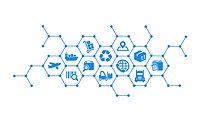COVID-19 and the Agile Supply Chain
Businesses need to take several steps in order to increase supply chain agility in the COVID-19 world.

The COVID-19 pandemic has disrupted supply chains all over the world, causing domestic shortages of products like produce, meat, and toilet paper on grocery store shelves. Prescription drugs, whose main ingredients come from China and are produced in India, will become in short supply because the countries are locked down and not shipping to the U.S. About 90% of all pharmaceutical ingredients are made outside the U.S., according to National Bureau of Economic Research.1
While food manufacturers have to ramp up to meet the increased demand, some plants are struggling with steep reductions. Automotive firms that use chemicals for paint, rubber, and plastics have seen reduced demand, forcing the auto plants to shut down. According to the American Chemistry Council (ACC), more than $3,000 worth of chemicals are used in every vehicle. When auto plants shut down, chemical manufacturers lose revenues.
According to the ACC’s chief economist, T. Kevin Swift, “Things are moving so fast [in the chemical industry]—it’s unparalleled in pace.”2 In the chemical industry and others, changes in economic conditions that would traditionally take months to develop are now happening in days. Many chemical producers have put expansions and capital expenditures on the back burner.
However, some chemical businesses have had to ramp up production efforts in response to the coronavirus pandemic. Those that offer hand sanitizers, masks, and other cleaners and preventive products are increasing production to help in the fight against the virus. Indeed, many plants are running continuously to fill the demand.
Adhesives and sealants manufacturers produce products for almost every industry, from construction to health care. Many of these organizations are retooling their manufacturing operations to create new product lines, such as face shields or hospital gloves.
During these trying times, companies need their supply chains to be more agile and flexible. Can the plant quickly change production lines over to manufacture more of one product? Can different production lines make the same product without having to be retooled? How many shifts can production lines run? How can companies get employees to come in and work on the production lines?
Businesses need to take several steps in order to increase supply chain agility. These involve focusing on being a demand-driven organization rather than one driven by forecasts, balancing supply and demand, and monitoring the impact of logistics.
Becoming Demand Driven
To survive in this COVID-19 world, companies need to gain visibility into their supply chains to collectively sense and properly respond to changes in supply and demand. They need a demand-driven supply chain that can provide an intelligent response to the change in the environment. This requires a digital network that enables collaboration across all stakeholders, orchestrating rapid responses to changes in flows.
Visibility into supply chains helps companies cope with flux and mitigate risk from impending changes in the market. Digitizing the supply chain automates transaction flows and supports lights-out processing of the manufacturing environment. When you digitize the supply chain, you have the foundation for a much more flexible and responsible supply chain. With visibility, companies can determine which suppliers can ship their orders, when the order will ship, and when it will be received.
Lots of plants remain shut down due to the coronavirus, which means companies can’t meet demand. With a collaborative digital network connecting all buyers, suppliers, and logistics service providers, companies can better meet demand because they have visibility into excess raw material stocks that can be diverted to another location where production is ramping up. Suppliers on the network can respond and confirm that they have the inventory and can ship product to a specific place in a certain amount by a certain date.
A demand-driven digital network allows collaboration among all trading partners so that companies can secure:
- Alternate sources of raw materials
- Additional modes of transportation
- Production facilities from plants sitting idle or that can ramp up their production lines
- New product lines that can be sold to make up for lost revenues
Balancing Supply and Demand
Balancing supply and demand is an art that requires real-time information and supply chain visibility to adjust supply or demand to maximize profits and customer satisfaction. A digital supply network that connects all collaborative supply chain partners provides the basis of information to balance supply and demand. As data is collected from transactions and communications across the network, companies gain insight into what is happening across their supply chains.
The network gives visibility to activities up and down the supply chain. Visibility encompasses not only sensing data but also how to analyze it and take appropriate action across the extended enterprise.
During this pandemic, many people and companies are panic buying to avoid being without much-needed materials (or things like toilet paper). The network can sense demand changes sooner, such as seeing an increase in change orders or a higher frequency of orders or cancellations. The network can send out alerts when changes are sensed within the ecosystem, providing companies the ability to respond appropriately. With an improved ability to sense demand and detect disruptions, companies can better secure alternative sources of transportation or materials from other providers on the network.
A collaborative supply network captures event and transaction data across the entire network, creating a critical mass of historical business information that can be used in predictive analytics. For example, if a carrier promises next-day delivery, predictive analytics would make a more accurate prediction of delivery, alerting users of a high probability of late delivery.
Some networks integrate with third-party networks and outside data feeds through application programming interfaces (APIs), such as economic data, gross national product (GNP) forecasts, weather forecasts, risk events, etc. This information can be presented to management to deliver the type of analytics that illuminates the meaning behind the data.
Monitoring the Impact of Logistics
During the COVID-19 pandemic, freight volumes have decreased while shipping costs have gone up; even the spot market rates are higher. The Transportation Marketing & Sales Association (TMSA) says that the world is in a “freight recession.” Many trucking businesses have gone away due to the lower freight volumes, which has led to a lower overall capacity in the market that makes it difficult to get orders shipped to end users.
By leveraging an integrated network of carriers, forwarders, terminal operators, and warehouse providers, along with other shippers and suppliers, companies can connect and collaborate to find capacity and better manage freight. Logistics data is gathered from the network, giving visibility to orders, delivery dates, shipment information, and costs.
Learning from Experience
Businesses can learn many lessons from this pandemic. They can take what has been learned and put the right supply chain processes in place to properly sense demand, become more flexible, and be better prepared for any future disruption to their supply chains. Significant benefits are gained, such as higher-order fulfillment rates, improved customer service levels, higher profitability, increased operational efficiency, and higher revenue growth.
For more information, visit www.elemica.com.
References
- N. Beste Kaygisiz, Y. Shivdasani, R.M. Conti, and E.R. Berndt, “The Geography of Prescription Pharmaceuticals Supplied to the U.S.: Levels, Trends, and Implications,” National Bureau of Economic Research, December 2019, www.nber.org/papers/w26524.pdf.
- Bomgardner, Melody M., “Coronavirus Starts to Weigh on Industry,” Chemical & Engineering News, April 1, 2020, https://cen.acs.org/business/economy/Coronavirus-starts-weigh-industry/98/i13.
Looking for a reprint of this article?
From high-res PDFs to custom plaques, order your copy today!









